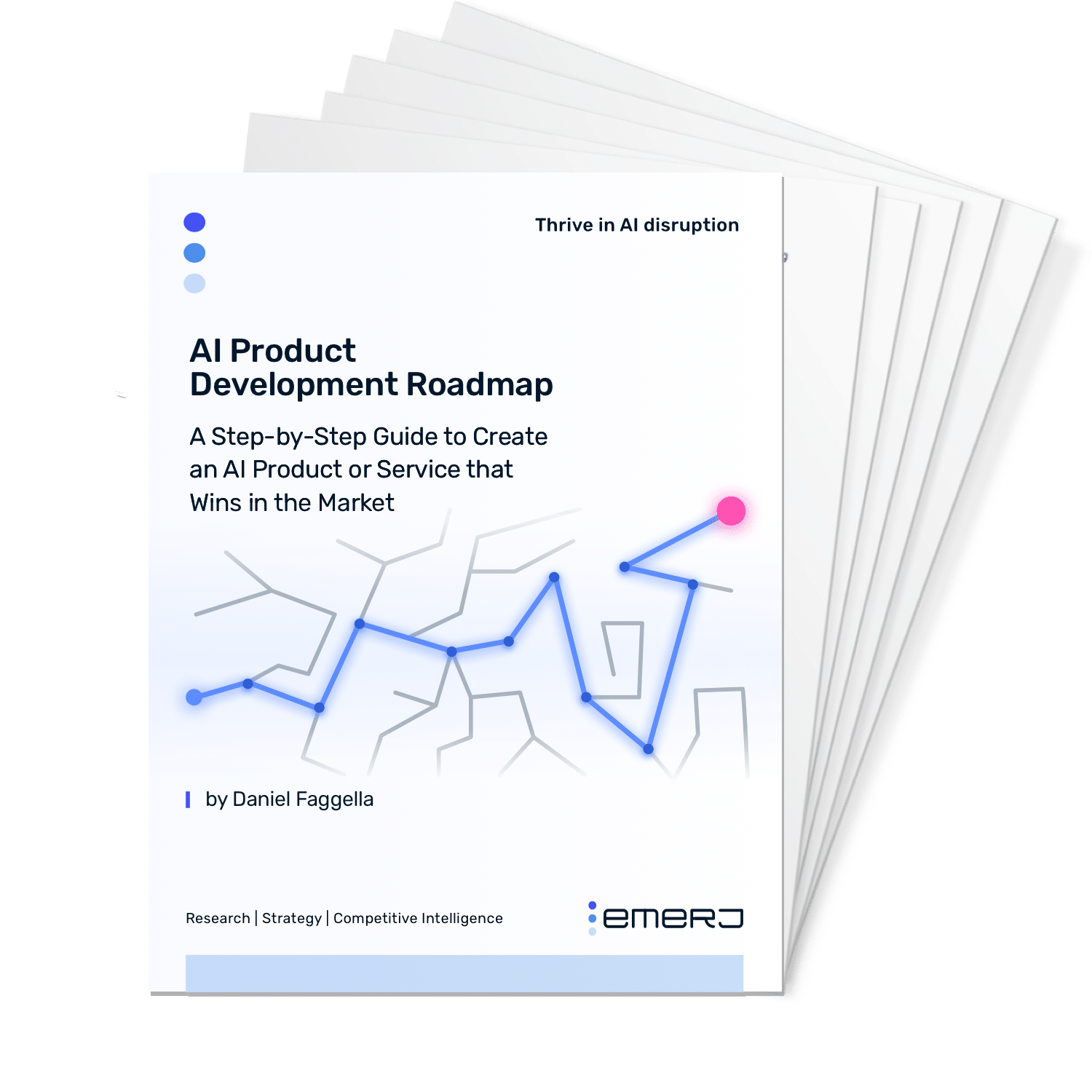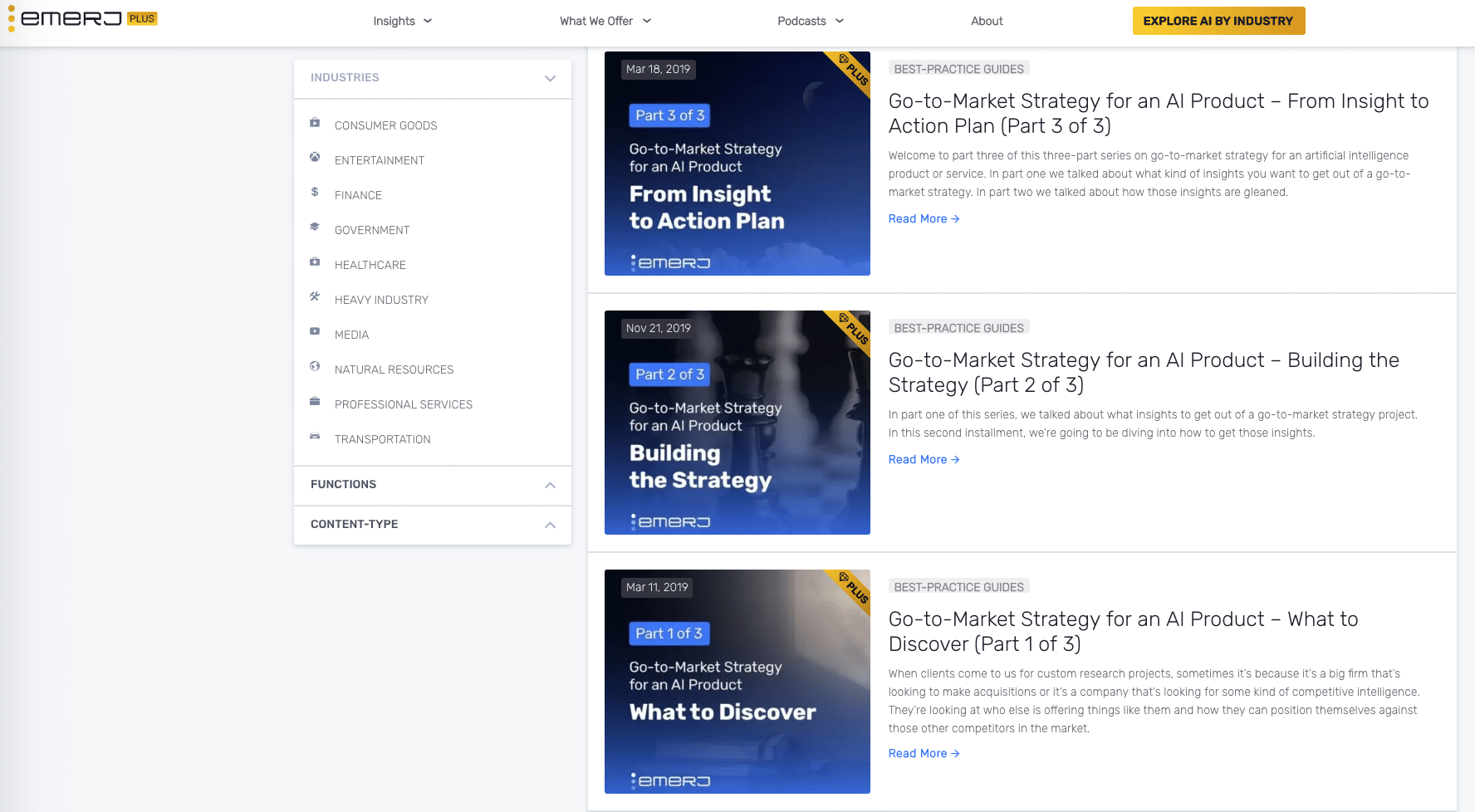This article was a request from one of our Catalyst members. The Catalyst Advisory Program is an application-only coaching program for AI consultants and service providers. The program involves one-to-one advisory, weekly group Q-and-A with other Catalyst members, and a series of proprietary resources and frameworks to land more AI business, and deliver more value with AI projects. Learn more at emerj.com/catalyst.
Developing an AI product or service offering involves a number of challenges that often aren’t faced with traditional IT products, including:
- An understanding of the level of AI fluency of our buyers (i.e. Do they understand AI? Are they afraid of, or too enthusiastic about AI?)
- The data infrastructure and data access of prospective clients
- … and the inherent uncertainty of building AI-based solutions, which are by their nature probabilistic, not deterministic
As the Catalyst program has grown and I spend more of my time working one-on-one with leaders of small and mid-sized firms who are developing their first AI offerings for the market. Just as important as providing these leaders with more ideas, is my role in focusing their efforts on the markets most likely to respond and benefit.
In this article, I’ll break down three compelling reasons to begin by focusing on niche markets, and walk through four approaches to determining a niche for your AI solutions.
Whether you’re an AI consultant or vendor, or an in-house AI product manager, this article should prove useful.
For AI vendors or aspiring vendors: This article will help you think through your initial target market and product features, and allow you to set more realistic goals for your go-to-market strategy.
For in-house AI solutions teams: The dream of “everyone can use it” is nearly just as elusive for teams developing in-house data science solutions as it is for teams selling into the broader market. This article should help you think through how to build solutions that your departments and teams will actually use, and ask the right questions to improve your fit along the way.
We’ll start off by addressing the benefit of niching down:
Reasons to Niche Down an AI Product or Service
My recommendation generally speaking is to figure out the kind of AI functions and industries you can actually serve. This is important because AI products and services are usually industry or function-specific. An AI vendor who claims to serve seven industries after raising $15MM will claim to work with two or three when they raise $50MM.

By industry, I’m referring to banking, pharmaceutical, retail, and so on. When I say function, I’m referring to customer service, marketing, fraud, and other horizontal business functions (often broken our as their own department within the enterprise). In other words, Industry and function-specific knowledge is needed to market your services.
What do I mean by that?
Let’s illustrate this with the example of chatbots. Let’s just say you’re in the business of developing conversational agents that can handle very simple, repetitive messaging.
If we want to market that service to everybody, what would marketing look like?
Each industry has completely different pockets of the business where simple chat replies are going to be viable. It might work with banking, but it might be a different scenario in eCommerce.
Even within banking, there are a near-infinite number of nuances and potential applications. The questions asked about credit cards and charges are often an entirely different universe from the questions about bank balances and money transfers. Large banks might have entirely different patterns of communication than smaller credit unions. Language is of course another factor – and between legal differences (GDPR or otherwise) and norms of speech and text, a chatbot for US retail banks will not be able to immediately be used by banks in the UK or Australia.
The integration environments are also likely to be different. While eCommerce firms or credit card firms may have robust digital infrastructure and access to online customer activity and customer records, older and less digitally savvy industries might have to make due with chatbot deployments that involve far less context.
While the total list might be longer – I’ll list three of the main reasons I generally advise vendors to begin with a niche focus for the product or service.
1. Marketing That Resonates
When we’re marketing, we want our buyer to say “Hey, this is for me. Hey, this resonates with me. Hey, this is solving my problem.”
If none of the prospects who see are marketing feel that resonance, we’re unlikely to see traction with our offering. This almost always spawns from a desire to pen the aperture to prospective clients, but this desire (when not tapered by an analysis of the market and its needs) usually backfires. To quote the Harvard Business Review:
“Every marketer’s dream is to discover some huge untapped or underserved customer segment and develop a killer offering for it. But segmentation strategies often fail because marketers cast their nets too wide and try to capture overly large, amorphous customer groups.”
The framing of our marketing message will directly affect who we’re attracting and what problems we’re addressing. It is the thing that gets people in the front door gets them hooked and thinking that we’re a good fit for them. Your marketing needs to resonate.
That resonance only happens when we have industry or function-specific knowledge.
2. Niche Users Need Niche Features and Services
Anybody that says we have a chatbot, a search and discovery tool, or some type of an oven system for customer service for all industries are not mature companies that raise a lot of money, have a lot of traction, or have figured out specific pockets where they really know the problem. If you’re applying chatbots in different kinds of businesses every two days, then there might not be enough commonalities you can find to actually deliver value for any individual business.
By selecting a niche, it’s going to help you deploy your services or products. It will help you figure out the in-depth problems and industry trends of credit card companies, chat streams, customer service, expense structures, call centers, and so on. If we know all of that, now all of a sudden we can build a better product or service.
Speaking of chatbots, our interview with Kasisto’s CTO Sasha Caskey is a strong example of how critical niche focus can be for AI vendors. Kasisto is one of the most well-known chatbot firms in financial services, and in this episode, Sasha breaks down the specific nuances that their firm has been faced with when building conversational interfaces for retail banking:
3. Branding and Awareness Starts with Focus
Getting good brand recognition is the name of the game if we’re going to be selling services and products. Closing big deals with
Building a “brand” in six industries at once is much harder than nailing branding for one specific market. AI vendors that sell well into multiple industries are more likely to be technical tools, data people or technical people selling to other data people and technical people. But most of the opportunity for AI product and services firms isn’t solving problems for data engineers or programmers, its for solving problems for businesspeople – VPs, Directors, “Heads of” in different departments.
95% of the vendor money in enterprise #AI involves selling to people who can't tell a line of Python from a line of Euripides.
3-4 years ago, 95% of AI vendors were founded by purely technical founders.
SMEs on founding teams is a good sign for AI's gradual adoption.
— Daniel Faggella (@danfaggella) November 13, 2020
If we can deploy successfully, we can create more lucrative and long-term partnerships, and build momentum for sales. When we have a number of clients in a given industry such as credit card companies, for example, our sales conversations are much more powerful when we can say we work with American Express and Discover. If we can say that, then it is much easier to sell to MasterCard. Bragging about working with American Express and Discover won’t help nearly as much in selling Merck or Bayer, or other firms in vastly different sectors.
Momentum for our brand – and momentum for our level of services and understanding of the customer – build as we knuckle down.
Four Approaches to Niche Selection
Now that we’ve discussed the why of niche selection, we can go ahead and talk about the how.
While there are a nearly inifinite number
1. Experience with Real Clients and Prospects
A client is someone who has done business with you and paid for (or at least piloted) your solution. For internal AI teams who aren’t “selling” a solution, a “client” might be a department or division of the business that has deployed and is actually using a solution you’ve developed.
A prospect is someone who might become a client, but who hasn’t piloted, bought, or used your solution yet.
Both groups can provide useful information to help us explore our options for niching and product development.
For clients, we might consider:
- Which titles, roles, industries have been most likely to pay?
- What problem are they paying to solve?
- What problems did they think they had when they first found us (or responded to us)?
- What problems of their did we actually solve or help with?
- Which clients do we deliver value and results for – and which tend to be failures?
If you’ve made enough sales (or done enough pilots or deployments) to help you make some relevant deductions, these are the questions you should really ask and take note of the answers for analysis. This can help you narrow down your choices of niches.
Of course, in the early days, many of us are not going to have a lot of sales, or not enough to make any real-world analysis of the experience. If we only have no or just a few sales, we can look at proxies to sales that will help inform us. They might not be as informative as actual sales that involve a check in there, but they have their value.
For prospects, the questions was can ask are slightly different:
- Who is calling you?
- Who is responding well when you reach them? (Title, industry, geo-region, etc…)
- What are the challenges they’re coming to you with?
- What marketing messages seem to be garnering the greatest response?
We can ask the question “Who’s calling us, sees our website and gets a hold of us? Who’s responding in a somewhat favorable way?” When we reach out, we reach out to pharmaceutical chief data officers. We reach out to banking chief security officers or perhaps the VP of compliance.
We can then ask “What problems and/or solutions are garnering the best response?” What are we talking about when people actually seem to resonate back to us? You need to note what they are most concerned about.
Are we talking about reducing compliance risk?
Are we talking about improving revenue? Are we talking about a particular workflow?
Are we talking about general industry trends that they know they need to address?
In banking, for example, they might be worried about more regulation coming and this is something that’s keeping them up at night. Whatever the concern, it is what will mostly likely resonate with a particular type of client, and you need to know what these are.
2. Needs of the Marketplace
The next thing we want to look at is the needs in the marketplace. It might be existing key challenges for that industry such as compliance for banks, drug development for pharmaceutical companies, or cost reduction in healthcare. These are existing long-term problems that are endemic to a particular industry.
It is also important to know the trends that are changing and shaking up a sector and occupying their attention. We can focus on a trend or a shift that is rocking the industry boat and leverage it to our advantage. The retail industry, for instance, has been in a bit of a seismic shift for quite a few years now, and being able to give them some stability would go a long way towards earning their gratitude.
Knowing the trends that lead to needs in the market and the long-term existing problems in a particular space can be extremely useful in helping you select your niche. That is, provided you are in a position to develop services or products that can provide solutions for them. This leads us to the next factor.
3. Internal Capabilities and Experience
We want to look at internal capabilities and experience. This refers to the type of industry experience you have in terms of clients or individual team members. If you are considering tapping into the pharmaceutical industry, have you worked with a lot of pharmaceutical companies before or do you have a lot of people on your team that came from that industry?
You might ask:
- In what industries or business functions does our team have the most business contacts and connections?
- In what industries or business functions does our team have the most skill and experience?
Context on business problems means potentially building a better product and finding a more realistic way to integrate that product. Having a rich rolodex of contacts means having warm conversations to product development, and maybe even initial pilot projects to gather testimonials or early case studies.
This consideration will apply to any industry or space because your expertise, skill, knowledge, and experience will determine the kinds of projects you can handle or products you can offer with a reasonable degree of success. You need to analyze if you have what it takes to actually deliver results in terms of technical solutions and knowledge.
4. Viable AI Solutions
Finally, we want to look at viable AI solutions. We want to look for realistic precedence and not best-case scenario for using AI to identified needs.
There is a tendency for AI services firms to create a situation where the problems and issues articulated by a potential client can be to submit that AI can do amazing things with AI. It is just a matter of building it and become this magic bullet to solve all of the client’s problems. You don’t want to do that.
The fact is if you’re a small or mid-sized consultancy or AI provider, you’re not going to be able to match what a company that just raised a hundred million dollars can do. They’re going to have more talent than you and they’re going to be moving faster in terms of products or services, and they’re going to be able to go way farther with AI than you.
What we want to do is think about the realistic precedents. We might say “Oh, we can have AI do X.” The question is, is that even realistic? Is AI even able to do that? Is it even possible for AI to solve that problem? If you’re doing something that Deloitte can do, and is doing, then you might have a problem competing with that.
However, if you’re focused on a sector, a business solution, or you can offer a different value proposition such as a set of features that could possibly address an area that Deloitte is not focusing on, you can still compete. They will want to do business with you.
You don’t need to be technically more advanced than them or even be technically different as long as you have a unique value proposition related to your features, benefits, or focus. The trick is to differentiate your company from the big companies while still promising realistic results based on precedent. This is going to help us determine our niche as well.
Defining Your Marketing Hypotheses

You would probably want to have conversations about the business functions or AI capabilities that you can potentially develop to figure out what you want to do in the long term. If you or any of your team members have never done anything with computer vision, for example, then it might not be something you really want to do.
When you have made a thorough examination and discussion of your capabilities and experience, you will then want to develop some strong hypotheses about which combinations are going to have the strongest appeal to potential clients. The goal here is to bootstrap off an existing portfolio as much as possible as this will provide real-world answers to who we already sold to, to whom were you able to deliver results, and what experience was most helpful in carrying out the project.
If you have just a few or no clients, you can obtain the data you need by beginning some sandbox projects with people with whom you already have relationships. You might even build some testimonials and get some traction before you go out into the bigger market. You might even close more deals with your existing customers.
An initial niche hypothesis should allow you to:
- Prioritize your outreach and outbound marketing efforts
- Determine the messaging on your website and brand materials
This hypothesis should include:
- The titles, industries, departments, and geographic regions you’re targeting (or even the exact companies you’re going to try to sell to first)
- The value proposition you’re going to lead with for your marketing and messaging
- The problems you solve for the customer
- (In the case of technical solutions) How we integrate into client workflows, and the level of API or data access we’ll need to do so
All hypotheses should be up for regular review.
After X months of contact with X industry, we should be able to pull together a meeting, look at our pipeline and our traction, and ask: “Should we continue pursuing this market?” and “Should we continue pursuing this marketing in this way?” Scheduling these meetings ahead of time, or having traction benchmarks (i.e. after 20 calls with prospective customers) will allow us to keep a “pulse” on how well out hypotheses are holding up, and which need to be refined or altered.






















